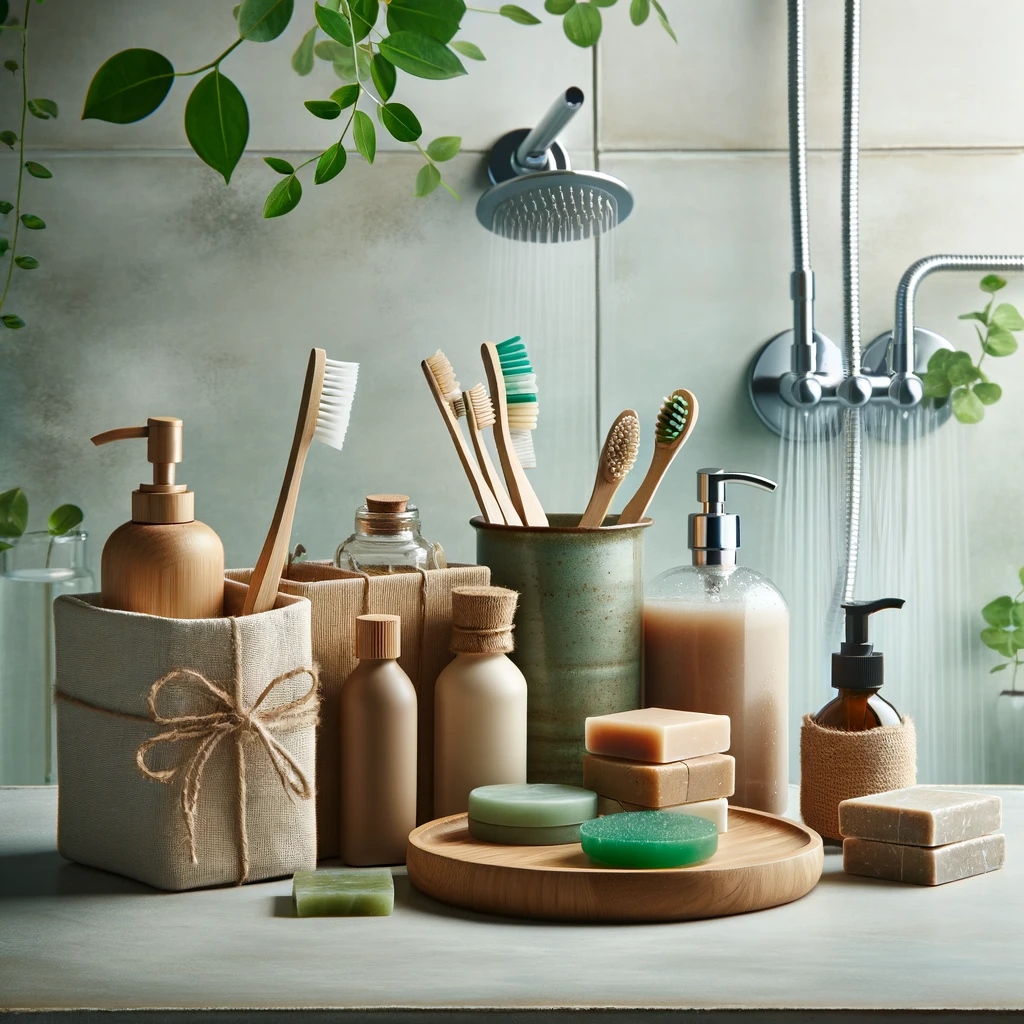In a world where environmental consciousness is increasingly vital, our daily choices take on new significance. From the products we use to the routines we follow, each decision can either contribute to ecological degradation or foster a greener, more sustainable future. One area where our choices have substantial consequences is our hygiene practices. By embracing eco-friendly hygiene solutions, we can reduce our ecological footprint, conserve resources, and safeguard the planet for generations to come. This article explores the importance of eco-friendly hygiene, delves into the environmental impact of conventional hygiene products, and guides you on choosing sustainable alternatives to make a positive impact on both your health and the environment.
| Topic | Tips and Tricks |
|---|---|
| 1. Dental Care | – Use a bamboo toothbrush and biodegradable toothpaste. |
| – Turn off the tap while brushing to conserve water. | |
| 2. Showering | – Install a low-flow showerhead to reduce water usage. |
| – Take shorter showers to save water and energy. | |
| 3. Hand Washing | – Use eco-friendly hand soaps with minimal packaging. |
| – Opt for a water-saving faucet aerator. | |
| 4. Menstrual Hygiene | – Try reusable menstrual cups, cloth pads, or period underwear. |
| – Properly clean and maintain reusable menstrual products. | |
| 5. Cleaning Products | – Choose natural and non-toxic cleaning agents. |
| – Make your own cleaning solutions using eco-friendly ingredients. | |
| 6. Waste Disposal | – Compost biodegradable hygiene products when possible. |
| – Dispose of reusable items responsibly, following manufacturer guidelines. | |
| 7. Eco-Friendly Certification | – Look for certifications like USDA Organic and Fair Trade. |
| – Research third-party eco-certifications for product trustworthiness. | |
| 8. Spreading Awareness | – Share your eco-friendly hygiene journey on social media. |
| – Educate friends and family about the benefits of sustainability. | |
| 9. Supporting Sustainable Brands | – Choose products from companies committed to eco-conscious practices. |
| – Reward and support businesses that prioritize sustainability. | |
| 10. Conserving Resources | – Turn off lights and reduce energy usage in your bath |
Eco-Friendly Hygiene: A Path to a Greener Lifestyle
In today’s world, our choices have a profound impact on the environment. From the food we eat to the products we use, every decision we make can either contribute to environmental degradation or help create a more sustainable future. One area where we can make a significant difference is in our hygiene routines. By adopting eco-friendly hygiene solutions, we can reduce our ecological footprint and live a more sustainable lifestyle.
Why Eco-Friendly Hygiene Matters
- Environmental Impact: Conventional hygiene products often contain harmful chemicals and are packaged in non-biodegradable materials, leading to pollution and waste.
- Resource Conservation: Sustainable hygiene choices can help conserve water, reduce energy consumption, and minimize the depletion of natural resources.
- Health Benefits: Eco-friendly hygiene products are often gentler on the skin and free from harmful toxins, promoting better health and well-being.
The Role of Individual Actions
- Collective Impact: Small changes in personal hygiene routines can collectively make a significant impact on environmental conservation.
- Advocacy: Supporting eco-friendly hygiene products and practices encourages manufacturers and governments to prioritize sustainability.
- Educating Others: Sharing knowledge about eco-friendly hygiene can inspire others to make environmentally conscious choices.
The Environmental Impact of Conventional Hygiene Products
Before we delve into eco-friendly hygiene solutions, it’s essential to understand the environmental repercussions of traditional hygiene products. Many conventional items, such as single-use plastic toothbrushes, disposable diapers, and chemical-laden cleaning agents, contribute to pollution, resource depletion, and the generation of non-biodegradable waste.
Single-Use Plastics: A Major Concern
- Toothbrushes: Plastic toothbrushes can take hundreds of years to decompose, filling landfills and oceans with plastic waste.
- Diapers: Disposable diapers are made from synthetic materials and contribute to overflowing landfills.
- Cleaning Products: Many conventional cleaning agents contain harsh chemicals that can harm aquatic ecosystems.
Resource-Intensive Manufacturing
- Water Usage: The production of hygiene products consumes vast amounts of water, putting additional pressure on water sources.
- Energy Consumption: Manufacturing processes often rely on fossil fuels, contributing to greenhouse gas emissions.
- Chemical Pollution: The release of toxic chemicals during manufacturing can harm both the environment and workers’ health.
Waste Management Challenges
- Landfills: Non-biodegradable hygiene products end up in landfills, taking up space and releasing harmful substances as they break down slowly.
- Ocean Pollution: Plastic waste from hygiene products finds its way into oceans, endangering marine life and ecosystems.
- Incineration: Burning hygiene products releases air pollutants and greenhouse gases into the atmosphere.
Choosing Eco-Friendly Hygiene Products: What to Look For
The first step in adopting an eco-friendly hygiene routine is to select products that align with sustainability principles. Look for the following features in eco-friendly hygiene products:
Biodegradability: Going Back to Nature
- Natural Breakdown: Eco-friendly products should break down naturally, reducing the burden on landfills.
- Less Pollution: Biodegradable items release fewer harmful substances during decomposition.
Minimal Packaging: Less Is More
- Recyclable Materials: Opt for products with packaging that can be recycled or repurposed.
- Reduced Plastic: Choose items with minimal plastic packaging to reduce plastic waste.
Non-Toxic Ingredients: Protecting Your Health and the Environment
- Chemical-Free: Check the ingredient list for harmful chemicals like phthalates, parabens, and sulfates.
- Natural and Organic: Look for products with natural or organic ingredients that are safer for you and the planet.
Reusable Options: Sustainable and Cost-Effective
- Cloth Diapers: Cloth diapers are washable and reusable, reducing the need for disposable ones.
- Menstrual Cups: Menstrual cups can be reused for years, reducing the waste generated by disposable tampons and pads.
- Cloth Pads: Reusable cloth pads offer a sustainable alternative to disposable menstrual products.
Certifications: Trustworthy Standards
- USDA Organic: Products with this certification adhere to strict organic farming practices.
- Fair Trade: Supporting fair labor practices and sustainable sourcing.
Eco-Friendly Hand Washing: The Basics and Benefits
Hand washing is a fundamental aspect of personal hygiene, but it can also be an opportunity to make an eco-friendly choice. Traditional liquid hand soaps often come in plastic bottles and contain synthetic chemicals. Switching to eco-friendly hand soaps can help reduce plastic waste and exposure to harmful substances.
To make your hand washing even more eco-friendly, consider installing a water-saving faucet aerator. This device mixes air with the water flow, reducing water consumption without compromising the quality of your hand washing.
Reducing Water Waste: The Eco-Friendly Way to Shower
Showering is another daily ritual where you can make eco-conscious choices. A typical showerhead can use a significant amount of water, contributing to water scarcity in some regions. To combat this issue, you can install a low-flow showerhead that reduces water usage while maintaining adequate water pressure.
Additionally, consider shortening your showers and turning off the water while lathering up or shampooing your hair. These small adjustments can save gallons of water over time.
Eco-Friendly Dental Care: A Fresh Approach to Oral Hygiene
Traditional dental care products often come with plastic packaging and disposable components. However, eco-friendly alternatives are available for a more sustainable oral hygiene routine. Bamboo toothbrushes, for instance, offer a biodegradable handle, reducing plastic waste.
For flossing, opt for natural silk or bamboo floss in recyclable packaging. And when it comes to toothpaste, choose brands that use recyclable or reusable containers.
Menstrual Hygiene: Sustainable Options for Women
Menstrual hygiene is an area where eco-friendly choices can significantly impact the environment. Instead of disposable menstrual products, consider reusable options like menstrual cups, cloth pads, or period underwear. These products not only reduce waste but also save you money in the long run.
Eco-Friendly Hygiene in the Bathroom: Making a Difference
Incorporating eco-friendly hygiene practices in the bathroom can be a small yet meaningful step toward a sustainable lifestyle. Be mindful of your water usage, choose products with minimal packaging, and explore DIY options to reduce waste and environmental impact.
The Future of Hygiene: Innovations for a Sustainable World
As awareness of environmental issues grows, so does the demand for eco-friendly hygiene solutions. The future holds promise with innovations such as biodegradable wipes, sustainable packaging, and advanced water-saving technologies. By staying informed and making conscious choices, we can contribute to a greener and more sustainable world.
Final Thoughts
The journey towards eco-friendly hygiene is not just an individual choice; it’s a collective responsibility to protect our environment and promote a sustainable future. By understanding the environmental impact of conventional hygiene products, advocating for eco-friendly choices, and educating others, we can make a significant difference. Embracing biodegradable, minimal packaging, non-toxic, and reusable hygiene products is a step in the right direction. Let’s continue to support sustainable practices, inspire change, and prioritize eco-conscious hygiene to ensure a cleaner, healthier, and more sustainable world for ourselves and generations to come. It’s time to make every aspect of our lives, including our hygiene routines, a part of the solution to environmental challenges.
FAQs
1. What is eco-friendly hygiene?
Eco-friendly hygiene refers to the practice of maintaining personal and household cleanliness while minimizing the negative impact on the environment. It involves choosing products and practices that are biodegradable, use fewer resources, and reduce pollution compared to conventional hygiene options.
2. Why should I switch to eco-friendly hygiene products?
Switching to eco-friendly hygiene products is beneficial for several reasons. It helps reduce pollution, conserve resources, minimize exposure to harmful chemicals, and contributes to a healthier planet. Additionally, eco-friendly products often have less packaging waste and may save you money in the long run.
3. What are some common eco-friendly hygiene products?
Common eco-friendly hygiene products include bamboo toothbrushes, biodegradable toothpaste, reusable cloth diapers, menstrual cups, organic soaps and shampoos, natural cleaning agents, and low-flow showerheads, among others. These products are designed to reduce waste and minimize environmental impact.
4. Are eco-friendly hygiene products as effective as conventional ones?
Yes, many eco-friendly hygiene products are just as effective as their conventional counterparts. Advances in sustainable product development have led to high-quality, environmentally friendly options that offer the same level of performance and cleanliness.
5. How can I dispose of eco-friendly hygiene products responsibly?
The disposal of eco-friendly hygiene products depends on the specific item. Biodegradable products can often be composted, reducing waste and returning nutrients to the soil. Reusable items, like cloth diapers or menstrual cups, should be cleaned and maintained properly to prolong their lifespan. It’s essential to follow the manufacturer’s instructions for each product.
6. Are eco-friendly hygiene products more expensive?
While some eco-friendly hygiene products may have a slightly higher upfront cost, they often prove to be cost-effective in the long run. For example, investing in a reusable product like a menstrual cup or cloth diapers can lead to significant savings over time, as they eliminate the need for constant repurchasing.
7. How can I encourage others to adopt eco-friendly hygiene practices?
You can encourage others by leading by example and sharing your knowledge and experiences. Discuss the benefits of eco-friendly hygiene, provide information on available products, and emphasize the positive impact on the environment and personal health. Engaging in eco-friendly hygiene practices as a family or community can also make the transition easier and more appealing.
8. Are there any certifications or labels to look for when choosing eco-friendly hygiene products?
Yes, some certifications and labels can help you identify eco-friendly products. Look for certifications like USDA Organic, Fair Trade, or third-party eco-certifications on product packaging. These labels indicate that the product meets specific environmental and ethical standards.
9. Can I find eco-friendly hygiene products in local stores, or do I have to order them online?
Eco-friendly hygiene products are becoming increasingly accessible, and you can often find them in local health food stores, eco-conscious boutiques, or major retailers. However, the variety and availability of products may vary depending on your location. Online shopping also provides a wide range of options and the convenience of home delivery.
10. What are the long-term benefits of adopting eco-friendly hygiene practices?
The long-term benefits of eco-friendly hygiene practices include reduced environmental impact, improved personal health due to fewer chemical exposures, potential cost savings, and the satisfaction of knowing you are contributing to a more sustainable and eco-conscious future for our planet.



